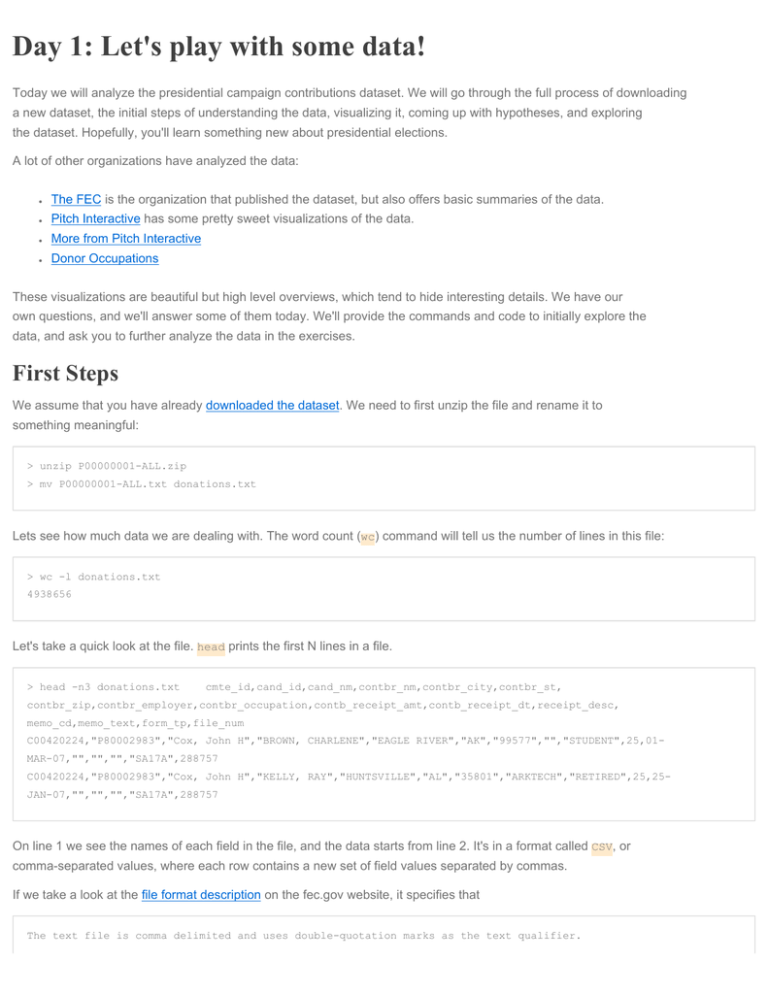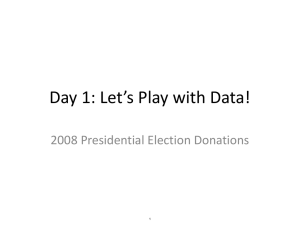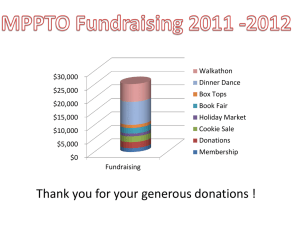Day 1: Let's play with some data!
advertisement

Day 1: Let's play with some data!
Today we will analyze the presidential campaign contributions dataset. We will go through the full process of downloading
a new dataset, the initial steps of understanding the data, visualizing it, coming up with hypotheses, and exploring
the dataset. Hopefully, you'll learn something new about presidential elections.
A lot of other organizations have analyzed the data:
●
The FEC is the organization that published the dataset, but also offers basic summaries of the data.
●
Pitch Interactive has some pretty sweet visualizations of the data.
●
More from Pitch Interactive
●
Donor Occupations
These visualizations are beautiful but high level overviews, which tend to hide interesting details. We have our
own questions, and we'll answer some of them today. We'll provide the commands and code to initially explore the
data, and ask you to further analyze the data in the exercises.
First Steps
We assume that you have already downloaded the dataset. We need to first unzip the file and rename it to
something meaningful:
> unzip P00000001-ALL.zip
> mv P00000001-ALL.txt donations.txt
Lets see how much data we are dealing with. The word count (wc) command will tell us the number of lines in this file:
> wc -l donations.txt
4938656
Let's take a quick look at the file. head prints the first N lines in a file.
> head -n3 donations.txt
cmte_id,cand_id,cand_nm,contbr_nm,contbr_city,contbr_st,
contbr_zip,contbr_employer,contbr_occupation,contb_receipt_amt,contb_receipt_dt,receipt_desc,
memo_cd,memo_text,form_tp,file_num
C00420224,"P80002983","Cox, John H","BROWN, CHARLENE","EAGLE RIVER","AK","99577","","STUDENT",25,01MAR-07,"","","","SA17A",288757
C00420224,"P80002983","Cox, John H","KELLY, RAY","HUNTSVILLE","AL","35801","ARKTECH","RETIRED",25,25JAN-07,"","","","SA17A",288757
On line 1 we see the names of each field in the file, and the data starts from line 2. It's in a format called CSV, or
comma-separated values, where each row contains a new set of field values separated by commas.
If we take a look at the file format description on the fec.gov website, it specifies that
The text file is comma delimited and uses double-quotation marks as the text qualifier.
The file contains information about the candidate, the donor's city, state, zip code, employer and occupation information,
as well as the amount donated. In addition it contains the date of the donation,
Let's write a script to read and print each donation's date, amount and candidate. Python comes with a csv module
that helps read CSV files.
import csv,sys,datetime
reader = csv.DictReader(open(sys.argv[1], 'r'))
for row in reader:
name = row['cand_nm']
datestr = row['contb_receipt_dt']
amount = row['contb_receipt_amt']
print ','.join([name, datestr, amount])
DictReader assumes that the first line are the names of the fields, and creates a dictionary for each row of
fieldname->value pairs. Copy the above code into a file (say exercise1.py) in the same directory as donations.
txt, and run python exercise1.py donations.txt. This will make donations.txt be the first argument to
the program (sys.argv[1]), which will be read and printed line by line. We'll only print the name, date, and amount of
the contribution for now.
Introducing matplotlib
We will be using matplotlib in the rest of the course, and work with it extensively in day 2. The following code is a
crash course on how to graph a line in matplotlib.
# pyplot is the plotting module
import matplotlib.pyplot as plt
import random
# generate the data
xs = range(10) # 0...9
ys1 = range(10) # 0...9
ys2 = [random.randint(0, 20) for i in range(10)] # 10 random numbers from 0-19
# create a 10-inch x 5-inch figure
fig = plt.figure(figsize=(10,5))
# draw a line graph
plt.plot(xs, ys1, label='line 1')
plt.plot(xs, ys2, label='line 2')
# create the legend
plt.legend(loc='upper center', ncol = 4)
# finally, render and store the figure in an image
plt.savefig('twolines.png', format='png')
plt.plot() takes a list of x and a list of y values, and draws a line between every pair of (x,y) points. The line is drawn
on the most recently created figure.
plt.legend() draws the legend in the figure. There are a bunch of other common chart objects like x-axis labels
that matplotlib supports.
In the final line, plt.savefig() saves the figure to a file called twolines.png in the directory we ran the script. Try it
out! You should see something like
Sampling The Data
The dataset is quite large, and processing the full dataset can be pretty slow. It is often useful to sample the dataset and
try things out on the sample before doing a complete analysis of all of the data. The following is a script that samples
the donations dataset. It will print 1 out of every 1000 donations (or roughly 5000 total donations):
import sys
with file(sys.argv[1], 'r') as f:
i = 0
for line in f:
if i % 1000 == 0:
print line[:-1]
i += 1
The line print line[:-1] prints the entire line except its last character to the screen. Why skip the last
character? Because each line ends in a carriage return, and print will add one for us. We don't want a space
between each line!
This script will print every thousandth line of whatever file you pass in as an argument to the screen. To create a new
file, use the > standard output rediretor.
python exercise3.py donations.txt > donations_sampled.txt
We will be analyzing Obama vs McCain data, so you can modify this code to create a file that only contains donations
for McCain and Obama. That way later analysis will run faster.
Plotting The Data
We learned how to iterate and extract data from the dataset, and how to plot lines, so we will now combine the two to
plot Obama's campaign contributions by date. We will compute the total amount of donations for each day, and
use matplotlib to create the charts.
from collections import defaultdict
import
matplotlib.pyplot as plt
import csv, sys, datetime
reader = csv.DictReader(open(sys.argv[1], 'r'))
obamadonations = defaultdict(lambda:0)
for row in reader:
name = row['cand_nm']
datestr = row['contb_receipt_dt']
amount = float(row['contb_receipt_amt'])
date = datetime.datetime.strptime(datestr, '%d-%b-%y')
if 'Obama' in name:
obamadonations[date] += amount
# dictionaries
sorted_by_date = sorted(obamadonations.items(), key=lambda (key,val): key)
xs,ys = zip(*sorted_by_date)
plt.plot(xs, ys, label='line 1')
plt.legend(loc='upper center', ncol = 4)
plt.savefig('/tmp/test.png', format='png')
A few notes about the code
●
defaultdict is a convenience dictionary. When we use a regular dictionary, it throws an error when we access a key
that doesn't exist:
>>> d = {}
>>> d['foo']
Traceback (most recent call last):
File "<stdin>", line 1, in <module>
KeyError: 'foo'
We provide defaultdict a function to call and return if the key doesn't exist. This is nice because we can assume
a default value. It is otherwise used as a normal python dictionary:
>>> d = collections.defaultdict(lambda:0)
>>> d['foo']
0
>>> d['bar'] += 1
●
We parse the dates using the datetime module's strptime function. The string %d-%b-%y is called a date format string.
●
In the loop that reads the data, we record the total donation amount for each date.
●
Finally, we need to sort the data in obamadonations by the date (the key). sorted(l, key=f) returns a sorted copy of
l and calls f to extract the key to use for comparison.
●
zip(*pairs) then unzips the list of pairs into two lists.
You should see something like this:
Great! It's interesting to see a spike in donations on August 2008 -- does it relate to the democratic party
nomination speech he gave on August 28th? At this point a reporter may try to understand some of the spikes in the graph.
But wait! There's a really weird dip in his donations in the lower right corner. How does someone give
negative donations? The next part will investigate this further.
The Case of the Negative Donation
The first thing we should do is look at some of the data where the donation amount is negative and see if there's
anything interesting. We can modify our existing code.
import csv,sys,datetime
reader = csv.DictReader(open(sys.argv[1], 'r'))
for row in reader:
name = row['cand_nm']
datestr = row['contb_receipt_dt']
amount = float(row['contb_receipt_amt'])
if amount < 0:
line = '\t'.join(row.values())
print line
Note that we cast amount into a float. The CSV module returns strings, so its our job to cast the data into the proper type.
If you scan through the output, you'll see data such as:
C00430470
DARIEN
RETIRED McCain, John S
SA17A
P80002801
068202003
VAN MUNCHING, LEO MR.
JR.
02-AUG-07
C00430470
CT
X
REATTRIBUTION TO SPOUSE 315387
LOS ANGELES EXECUTIVE
LEIWEKE, TIMOTHY J. MR. 30-APR-08
REDESIGNATION REQUESTED -2300
McCain, John S
CA
X
REATTRIBUTION TO SPOUSE -2300
SA17A
P80002801
900492125
REFUND; REDESIGNATION REQUESTED 364146
A.E.G.
REFUND;
Lots of text, but "REDESIGNATION TO GENERAL" and "REATTRIBUTION TO SPOUSE" pop out as pretty strange.
It turns out that "redesignations" and "reattributions" are perfectly normal. If a donation by person A is excessive, the
part that exceeds the limits can be "reattributed" to person B, meaning that person B donated the rest to the
campaign. Alternatively, the excess amount can be redesignated to another campaign in the same party. So a donation
to Obama could be redesignated to a poor democrat in Nebraska.
What's fishy is "REATTRIBUTION TO SPOUSE." A quick google search gives a potential theory: that this is a tactic to
hide campaign contributions from CEOs. A CEO will donate money, which will be reattributed (refunded) to the
CEO's spouse. Then the humble spouse will turn around and donate the money to the candidate. In this way, it's hard for
a casual browser to notice that the candidate is backed by a company's CEOs.
Exercise 1: Plot Obama vs. McCain
So far we have only plotted Obama's campaign donations. Modify the script to also plot McCain's donations on the
same chart. It should look something like:
Whoa whoa whoa, what was McCain up to March 2008? That's a whole lot of negative donations! We'll deal with that in
a few exercises.
Exercise 2: Cumulative Graphs
Word on the street says that Obama's donations eclipsed McCain's donations. Let's see if that's true. Plot the
cumulative donations (for a given date, plot the total donations up to that date). It should look something like:
Exercise 3: Understand "Reattribution to Spouse"
Let's now filter the contributions to only see the cumulative "reattribution to spouse" donations. Which candidate do
the dark, hooded CEOs prefer?
You will need to find the name of the field that contains the "reattribution" text, and filter on that field. Depending on
how you filter it, you may get different results. Try out a few ways to see what happens.
Exercise 4: Pause and Think
It's time for a reality check. If you saw the graph in the previous exercise, you would think "That's a lot of
negative donations! This candidate is really sneaky." Don't believe that just yet. Re-plot the ratio between
each candidate's cumulative "reattribution to spouse" donations and that candidate's cumulative overall donations.
That changes our offenders quite a bit.
Key Lesson: don't automatically trust charts in the wild. It's easy to make a chart say
whatever you want by selectively leaving out data!
Done!
Congrats! You are now a data sleuth. To recap the process we just went through we:
1. Took a quick look at the data using head to get a sense of what we're dealing with. We also figured out the format of
the data. This is usually important, because the fields are otherwise somewhat non-sensical!
2. Create a quick, initial visualization of some of the data fields and see if there are interesting trends.
3. Listen to your hunch, and form a hypothesis around it
4. Figure out why the trend exists
5. Filter the dataset to the "interesting portion" and go to step 2
Tomorrow, we will dive deeper into matplotlib's visualization facilities, and further analyze the data using
different visualizations.
Related Datasets
If you are interested more campaign finance data, you can also download the campaign expense data from the
same website, if you click the "expenditures" tab in the right table.
MIT OpenCourseWare
http://ocw.mit.edu
Resource: How to Process, Analyze and Visualize Data
Adam Marcus and Eugene Wu
The following may not correspond to a particular course on MIT OpenCourseWare, but has been
provided by the author as an individual learning resource.
For information about citing these materials or our Terms of Use, visit: http://ocw.mit.edu/terms.






